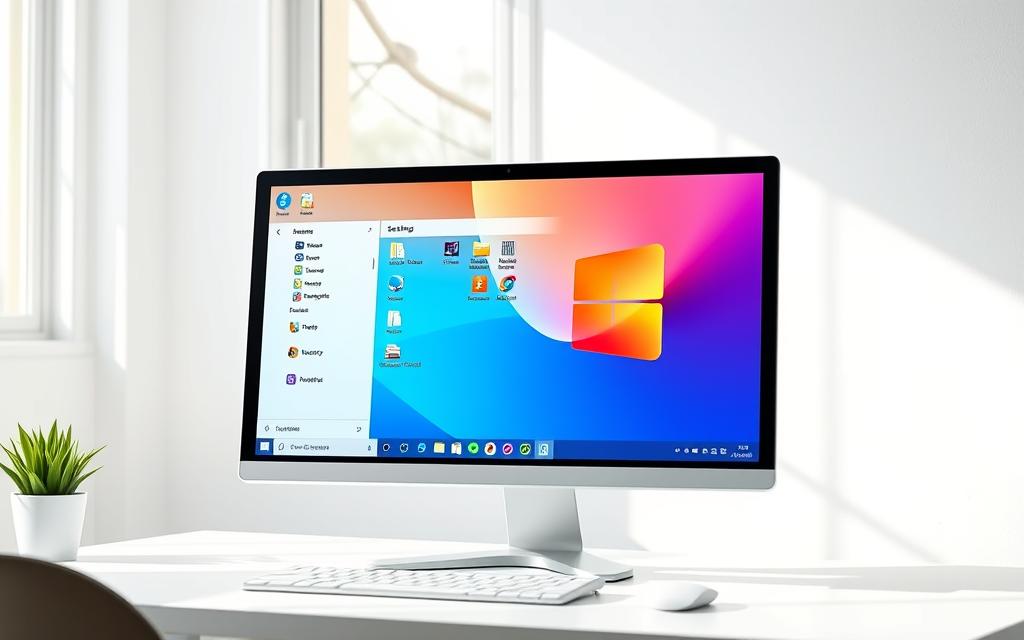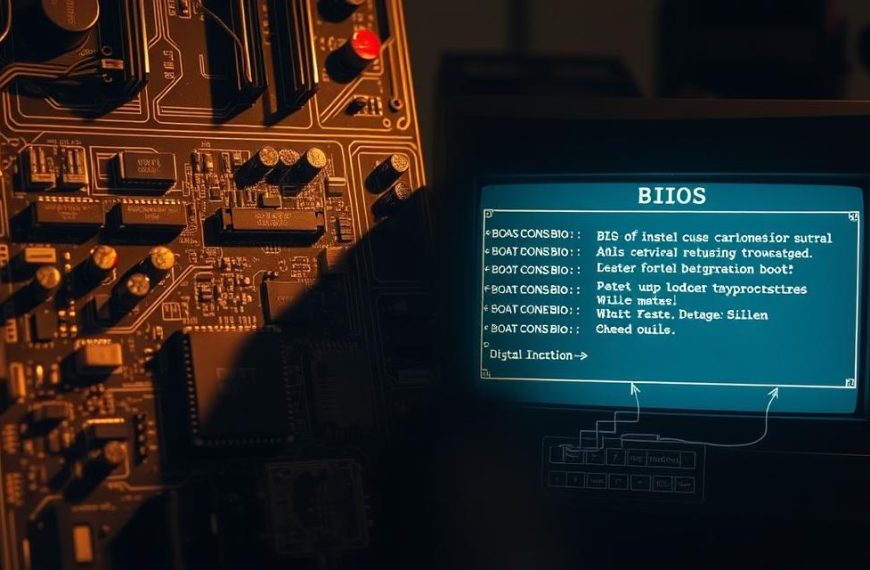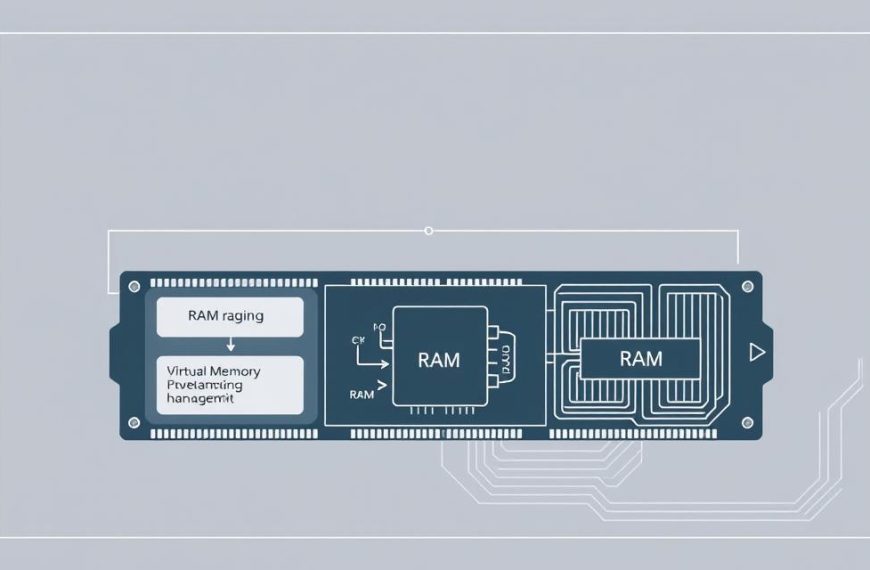Your computer’s operating system is like its brain. It controls the hardware and helps programs run smoothly. Knowing your OS version is very important for many reasons.
Knowing where your operating system is helps you install the right software. It also lets you get important security updates and get help when you need it. This is really useful when you’re fixing problems or making your computer better.
There are a few main operating systems out there. You might have Microsoft Windows, Apple’s macOS, or Linux. Each one works differently and has its own way of showing you system info. For more help on understanding operating systems, there are other resources online.
This guide will show you how to find your operating system details. It doesn’t matter what kind of computer you have. Just follow the simple steps to find what you need in your device’s settings.
Understanding Your Computer’s Operating System
Your computer’s operating system connects your hardware to your daily tasks. It manages basic operations, letting you use apps and devices easily.
Modern operating systems do many important jobs. They keep your computer running well:
- Hardware management talks to your computer’s parts like processors and memory
- Program execution lets apps run smoothly and safely
- Resource allocation shares computer power fairly among programs
- User interface provision makes the visual part of your device
Different operating systems look and work differently. Windows has a Start menu and taskbar, while macOS uses the Dock and Menu Bar. These interfaces help you organise your device, even if they look different.
File systems are key to how data is stored and found. Windows often uses NTFS, and macOS uses APFS. Both are designed for today’s storage needs and security.
System settings and control panels help you manage your computer. You can change display settings, user accounts, and security here. But, finding these settings can be different for each operating system.
Basic tasks like finding files and launching apps are similar across platforms. Knowing how to navigate these tasks is useful. It helps when you need to find your Windows OS version for software or troubleshooting.
The operating system has layers, but most users only see the top level. Knowing about deeper tools helps explain why there are many ways to find system specs.
Where Can I Find the Operating System on My Computer Using System Settings
System settings are the best way to find your computer’s operating system. This method works on all major platforms without extra software. You can see detailed system specs through easy-to-use menus.
Locating System Information on Windows 10 and 11
Windows has several ways to check your operating system details. Both methods give you full info on your system version and specs.
The Settings app is the modern way to get system info. Just follow these simple steps:
- Click the Start menu and select the Settings gear icon
- Navigate to System > About
- Find your Windows specification under Windows specifications
This section shows your edition, version, and installation date. You’ll also see basic hardware info and your operating system details.
Accessing System Properties via Control Panel
The Control Panel method is available for those who like classic interfaces. Here’s how to access it:
- Press Windows key + R to open Run dialog
- Type “control panel” and press Enter
- Select System and Security > System
This view shows your Windows edition, system type, and computer name. It offers the same core info as the Settings app but in a different way.
Finding macOS Version Information
Apple’s macOS has a unified way to check your operating system details. The process is the same across recent versions.
Using About This Mac Feature
The About This Mac window gives you essential macOS system info. Follow these easy steps:
- Click the Apple menu in the top-left corner
- Select About This Mac from the dropdown menu
- View your macOS version, model name, and processor details
For more detailed macOS system info, click System Report. This view shows hardware specs and software versions. It helps you understand your system’s capabilities and needs.
Checking Linux Distribution Details
Linux distributions have different settings interfaces. But, terminal commands give consistent results. These methods work on most popular distributions.
Terminal Commands for Linux Systems
Terminal commands are the most reliable way to check Linux system info. Use these common commands:
- lsb_release -a: Shows distribution-specific info
- cat /etc/os-release: Displays detailed operating system data
- uname -a: Provides kernel version and system architecture
These commands work on Ubuntu, Fedora, Debian, and most other distributions. They give precise info about your Linux version and build details.
Remember to check your distribution’s documentation for graphical alternatives. Some desktop environments have system settings panels with similar info.
Using System Information Tools
Windows and macOS have special tools that show more than just your OS version. These system information tools give detailed info on hardware, software, and system status. They are key for fixing problems and understanding your system.
Windows System Information Utility
The Windows System Information tool is found by typing msinfo32 in the Run dialog or search bar. It gives a full view of your computer’s setup. It sorts info into groups like hardware, components, and software.
It shows details on your processor, memory, storage, and more. The software section lists driver versions, running tasks, and startup programs. It’s vital for finding hardware issues or checking if your system can run demanding apps.
Unlike basic settings, System Information shows technical details like IRQ assignments and memory address ranges. These details help experts solve complex problems that basic info can’t.
macOS System Report
macOS users find the System Report in the About This Mac window. Click the System Report button to open a detailed hardware and software list. It’s more detailed than the basic overview screen.
The report gives full specs for every Mac component. It shows memory, storage, graphics, and peripherals. The software section lists apps, extensions, and system frameworks with versions.
Network settings are shown with interface details, connection status, and active services. The report also has diagnostic info on hardware performance and issues. It’s great for fixing problems or getting ready for upgrades.
Both these system information tools are for experts and advanced users. They offer the detailed info needed for system optimisation, checking compatibility, and solving complex problems.
Command Line Methods for Technical Users
For those who love terminal interfaces, command-line methods are the best way to OS identification. They give you more system info than graphical interfaces do.
Windows Command Prompt and PowerShell
Windows has many command-line tools for finding out your OS. The Command Prompt is a key tool for this.
Try the winver command to see your Windows version in a pop-up. For even more info, use systeminfo to get system config details.
PowerShell users can use Get-ComputerInfo. It shows data like OS name, version, and build number.
Terminal Commands on macOS and Linux
Unix-based systems like macOS and Linux have strong terminal commands for system info. Start with uname.
Use uname -a to see all system info. macOS users can use sw_vers for Apple-specific version info.
Linux users can use lsb_release -a for release info. Or check /etc/*release files with cat commands.
For a full guide on command line OS check methods, including BSD and others, tech users will find lots of examples and how-to’s.
Third-Party System Information Applications
While your computer’s built-in tools give basic info, third-party apps offer deep insights. They show detailed analytics that go beyond what your OS can do.
Many people like these apps for their detailed monitoring and easy-to-use design. They make complex data easy to understand for everyone, from casual users to IT experts.
Recommended Free System Information Tools
There are many free apps that are great for system analysis on different platforms:
- HWiNFO: Gives deep hardware analysis for Windows with real-time monitoring
- Speccy: Shows clear info on system components and temperatures
- Belarc Advisor: Creates detailed security profiles and software lists
- Hardinfo: Great for Linux distribution check and hardware analysis
- iStat Menus: Offers detailed macOS system monitoring
These tools are great at showing processor specs, memory, and storage details. They also have temperature monitoring and performance tests to show what your system can do.
Many apps let you save system reports for support or planning upgrades. This is very helpful when you’re getting new hardware or fixing system problems.
When you download these tools, make sure to get them from official sites. Check the checksums if you can. Good developers keep their download sites safe and update their apps often to match new hardware and OS versions.
For Linux users, there are graphical tools that make checking your distribution easy. These apps show kernel version, desktop environment, and package info in a clear dashboard.
The best thing about these tools is how they bring together info from different system sources. They make detailed profiles that help users decide on system care and upgrades.
Common Scenarios Requiring OS Information
Knowing your computer’s operating system version is more than just tech talk. It’s key in many everyday situations. It affects how well your system works with other software and hardware.
Software Compatibility Checks
Before you install new software, check your OS version. Many apps only work on certain OS versions. This is because developers make them for specific systems.
Trying to use software not made for your OS can cause problems. You might face:
- Installation failures or incomplete installations
- Programme crashes and unstable performance
- Missing features or reduced functionality
- Security vulnerabilities from unsupported software
Knowing your OS version helps you avoid these issues. It saves time and ensures your software works well.
Technical Support Situations
When your computer has problems, tech support will ask for your OS details. They need this info to:
- Identify known issues specific to your OS version
- Provide appropriate troubleshooting steps
- Recommend compatible solutions and updates
- Determine if your system requires upgrading
Having this info quickly helps solve problems faster. Tech support can get straight to fixing your issue without delay.
Whether you’re talking to manufacturer support, online forums, or IT experts, give them your OS details. This helps fix both software and hardware issues, where drivers need to match your OS version.
Conclusion
It’s vital to know how to find your operating system details. This helps keep your computer safe, ensures software works well, and fixes problems. This guide has shown you several ways to do this, from easy steps to more complex methods.
For everyday users, checking system settings is the fastest way. Those who like to dig deeper might use command-line tools. IT experts often use detailed system tools for thorough checks.
Now you know how to find your OS info easily. This skill lets you choose the right software, keep your system updated, and maintain it well. You’re now ready to handle your computer’s needs with confidence.

















